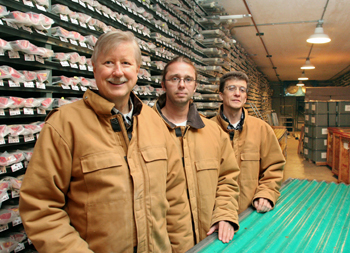'New' ancient Antarctic sediment reveals climate change history
Recent additions to the premier collection of Southern Ocean sediment cores at Florida State University's Antarctic Marine Geology Research Facility are giving international scientists a close-up look at fluctuations that occurred in Antarctica's ice sheet and marine and terrestrial life as the climate cooled considerably between 20 and 14 million years ago.

FSU's latest Antarctic sediment core acquisition was extracted from deep beneath the sea floor of Antarctica's western Ross Sea, the Earth's largest floating ice body. The new samples—segments of a drill core that measures more than 1,100 meters in length—offer an extraordinary stratigraphic record of sedimentary rock from the Antarctic continental margin that documents key developments in the area's Cenozoic climatic and glacial history.
By correlating that stratigraphic record with existing data and climate and ice sheet models, scientists from FSU and around the world expect to learn how local changes in the Southern Ocean region relate to regional and global climate events.
"Such knowledge will significantly increase our understanding of Antarctica's potential responses to future global-scale climate changes," said Sherwood W. Wise, Jr., an FSU geological science professor and co-principal investigator at the Antarctic Marine Geology Research Facility. "This is critical for low-lying regions such as Florida that could be directly affected by the future behavior of the Antarctic Ice Sheets and any resulting sea-level changes. By studying these glacial records of the past, geologists and climatologists seek to better predict the future."
The new cores came to FSU compliments of ANDRILL (ANtarctic geological DRILLing), an international collaboration among more than 120 scientists—plus drillers, engineers, educators and technicians—from Germany, Italy, New Zealand and the United States. FSU's Antarctic Marine Geology Research Facility and its staff and associated geological science faculty play a key ANDRILL role, providing both on-the-ice curatorial services during the drilling season and a permanent repository for the core samples recovered during the project.
In fact, from April 29 through May 3, some 100 ANDRILL scientists and educators, including seven from the FSU "on-ice" curatorial team, converged at the Antarctic Marine Geology Research Facility core repository. They re-examined the latest core acquisitions to refine their descriptions of the material and take additional samples for tests to extract even more information about their history and the conditions under which the sediments were deposited.
Those hard-won, deep-sea sediment cores may be millions of years old, but the scientists will find them in mint condition at FSU. The Antarctic research facility carefully curates the samples in its large, 6,000-square-foot refrigerated "Cold Room," which is maintained at 34 F. (i.e., sea-bottom temperatures).
"The sediment cores recovered during this year's successful ANDRILL expedition have filled in a major gap in the most direct record of the ice activity yet recovered from the period of about 20 to 14 million years ago," said Wise, who serves ANDRILL as a participating (off-ice) scientist and member of its U.S. advisory committee. "The 1,139 meters of core retrieved, 98 percent intact, records the critical transition from times warmer than today to the onset of major cooling between about 14 to 13 million years ago when a semi-permanent ice sheet formed across most of Antarctica."
That record was created, said Wise, because sediments deposited close to or beneath grounded glaciers alternate with marine sediments, providing clear evidence of cyclical ice advances followed by substantial retreats and reflecting variations in sea-level, glacial and climate fluctuations. The new stratigraphic section housed at FSU will allow scientists to devise more accurate models of the timing of past ice-sheet movements, volume changes and variability, and paleotemperature fluctuations, and will enable a better understanding of the development of Antarctica's terrestrial and marine life.
The Antarctic Marine Geology Research Facility was established at FSU in 1963 through the National Science Foundation's Office of Polar Programs and now serves as the national repository for geological material from the Southern ocean. It functions as one of the university's two user facilities (the National High Magnetic Field Laboratory is the other) for visiting researchers from around the globe.
ANDRILL's meeting took take place throughout FSU's Carraway Building—home to the Department of Geological Sciences and the annex that houses the Antarctic Marine Geology Research Facility. During the workshop one of the two chief scientists of the second ANDRILL expedition, David M. Harwood, an FSU master's graduate (1982) and a geology professor at the University of Nebraska-Lincoln, was honored with a special alumni award.
Visiting ANDRILL researchers who attended last May's inaugural post-drilling workshop at FSU noticed that since then the Antarctic research facility's core repository has undergone a major renovation to make room for recent acquisitions and future ones. Funding for those improvements to one of the coolest places on campus came from the National Science Foundation.
"The sediment cores recovered during this year's successful ANDRILL expedition have filled in a major gap in the most direct record of the ice activity yet recovered from the period of about 20 to 14 million years ago."
Sherwood W. Wise, Jr.
FSU Department of Geological Sciences